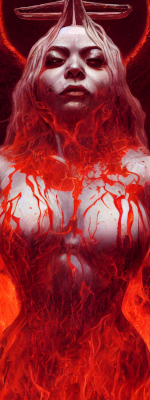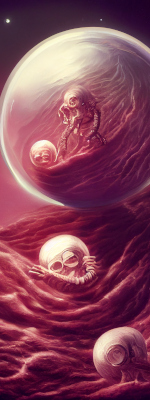Cult

With the wave of disasters at the end of the Earthly Age, the survivors united under a single faith, which became known as the Cult.
Earthly Age
The Cult was long a secret society connecting chosen individuals. Its mystery and rumors of power associated with membership made it a subject of interest for many. Gradual growth in popularity, especially among those craving power, eventually led to connections with organized crime. Towards the end of the Earthly era, the Cult gained significant influence by controlling humanitarian aid in vast regions of the world. During the last decades of the planet's existence, Cult membership became almost essential for survival.
The transformation from a secret organization to a public institution brought about a catharsis, turning the Cult into a dominant religious force. During its growth, the Cult absorbed various religious movements, shaping its current form.
In this age, the Cult had an ambivalent relationship with technology. It was skeptical of the technological marvels that had brought about wars but simultaneously recognized their potential.
Cosmic Age
With the advent of a new era, the Cult did not lag behind. Human colonies scattered across the Solar System became sought-after destinations for Cult members. In this unspoiled environment, the Cult emerged as a leading religious, economic, and military power.
In the new age, the Cult strives to create new structures inspired by dogmas derived from ancient times, particularly from organized crime and the history of Earth and Sun worship.
In this era, the Cult embraced the use of technology.
Beliefs
Cult supporters believe in the inevitability of Disease X and adhere to the Theory of Divine Fate.
The Cult's faith rests on the belief that uniting all religions is the key to a new beginning, to gaining the strength to face Evil.
Symbolism
 The Cult emphasizes its unity through symbolism drawing from various religious and spiritual traditions. As part of their unification, they also adopted the tradition of human sacrifices as a necessary condition for maintaining cosmic balance.
The Cult emphasizes its unity through symbolism drawing from various religious and spiritual traditions. As part of their unification, they also adopted the tradition of human sacrifices as a necessary condition for maintaining cosmic balance.
Belief in Deities
The Cult's pantheon includes one supreme and four lower gods associated with elements symbolizing key aspects of life and nature.
Marduk, the Supreme God
In the Cult, Marduk is regarded as the supreme deity symbolizing victory over chaos and order in the universe.
Cult members worship the gods through rituals involving human sacrifices to maintain cosmic balance. Worshiping Marduk reflects their belief in his power and protection, strengthening their faith in the divine plan and the Cult's mission in the universe.
The tattoos worn by Cult members often feature symbols of Marduk, regarded as sacred and connected to the cosmic order.
Agni, the Fire God

Agni is worshiped as the deity associated with fire, thermal energy, and stars.
Cult members see Agni as a symbol of energy, transformation, and purifying power.
Fire worshippers are known for their purification rituals, cleansing Disease X.
Prithvi, the Earth God

Prithvi is seen as the deity associated with solid ground and the matter of the universe. In the cosmic age, particularly in relation to asteroids.
Cult members honor Prithvi as a symbol of stability, material abundance, and wealth.
Worshiping Prithvi is especially prevalent among miners.
Varuna, the Water God

Varuna is recognized as the deity associated with water and life.
Cult members believe that worshiping Varuna grants them life force connected to flowing water. Water constitutes our bodies and is the foundation of life's cycle.
Everything related to organic matter falls under Varuna's domain, especially food, fertility, breathable air, biological processes, including black liquid and Disease X.
Vayu, the Air God

Vayu is regarded as the deity associated with air.
Cult members honor Vayu as a symbol of space beyond matter, including cosmic space and the processes within it. They believe that even the processes occurring in the universe showcase Vayu's power.
Thus, he is worshiped by pilots, navigators, and astronomers.
Caste System
Leaders
The highest authority in the Cult. Leaders have absolute control over the organization, deciding on directions and priorities.
Initiates
These members form the core of the organization and are divided based on their status and abilities. Senior initiates may have greater responsibilities and significance within the Cult's structure.
Brothers
A group of members at the same level of hierarchy. These individuals form a solid connection between branches and participate in decision-making within their group.
Aspirants
Aspirants must demonstrate their dedication and skills. They are often mentored by senior members to introduce them to the Cult's customs and values.
Servants
The lowest caste in the Cult's hierarchy. They serve higher members and are responsible for the organization's daily operations. While their dedication may lead to advancement, they generally remain at the lowest level of the social structure.
Perspective on Exile
For the Cult, leaving Earth is not merely a physical exodus but a spiritual act symbolizing departure from the past, ending old orders.
Perspective on Disease X
Cult members view Disease X as an inevitable part of the divine plan and a test for those deemed worthy of a new beginning. They believe the disease is a manifestation of divine judgment and a necessary tool to elevate human existence to a higher purpose. The afflicted are referred to as "the damned" and are seen as those who failed the divine test.
Cult members are concerned about Humanity's attempts to cure Disease X. From their perspective, such efforts are considered interference with natural development and the divine plan. They believe these attempts create "ghouls" – beings perceived as distorted and detestable versions of humanity. This concern is rooted in the belief that such actions contradict divine will and condemn those meant to undergo Disease X.
Intolerance
This disagreement over approaches to Disease X and the creation of "ghouls" is a fundamental reason for hostility between the Cult and Humanity.
Unlike Humanity, they do not consider other races, including Neanderthals or symbionts, inappropriate. Symbiosis is widespread within the Cult, and Neanderthals hold high positions alongside humans.

